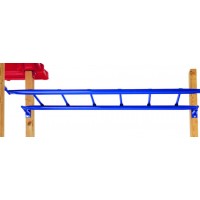Climbers, Overhead, Horizontal

Public Playground Safety Handbook
CPSC Publication 325
U.S. Consumer Product Safety Commission
5.3.2.4 Horizontal (Overhead) Ladders
Horizontal (overhead) ladders are a type of climber designed to build upper body strength. They are designed to allow children to move across the ladder from end to end using only their hands. Four-year-olds are generally the youngest children able to use upper body devices like these; therefore, horizontal ladders should not be used on playgrounds intended for toddlers and 3-year-olds. The recommendations below are designed to accommodate children ages 4 through 12 years.
• The first handhold on either end of upper body equipment should not be placed directly above the platform or climbing rung used for mount or dismount. This minimizes the risk of children impacting rigid access structures if they fall from the first handhold during mount or dismount.
• The horizontal distance out to the first handhold should be:
– No greater than 10 inches but not directly above the platform when access is from a platform.
– At least 8 inches but no greater than 10 inches when access is from climbing rungs.
• The space between adjacent rungs of overhead ladders should be greater than 9 inches to prevent entrapment.
• Horizontal ladders intended for preschool-age children should have rungs that are parallel to one another and evenly spaced.
• The maximum height of a horizontal ladder (i.e., measured from the center of the grasping device to the top of the protective surfacing below) should be:
– Preschool-age (4 and 5 years): no more than 60 inches.
– School-age: no more than 84 inches.
• The center-to-center spacing of horizontal ladder rungs should be as follows:
– Preschool-age (4 and 5 years): no more than 12 inches.
– School-age: no more than 15 inches.
• The maximum height of the take-off/landing platform above the protective surfacing should be:
– Preschool-age (4 and 5 years): no more than 18 inches.
– School-age: no more than 36 inches.
5.3.2.5 Overhead Rings Overhead rings are similar to horizontal ladders in terms of the complexity of use. Therefore, overhead rings should not be used on playgrounds intended for toddlers and 3-year-olds. The recommendations below are designed to accommodate children 4 through 12 years of age. Overhead rings differ from horizontal ladders because, during use, the gripped ring swings through an arc and reduces the distance to the gripping surface of the next ring; therefore, the spacing distance recommendations for horizontal ladders do not apply.
• The first handhold on either end of upper body equipment should not be placed directly above the platform or climbing rung used for mount or dismount. This minimizes the risk of children hitting rigid access structures if they fall from the first handhold during mount or dismount.
• The horizontal distance out to the first handhold should be:
– No greater than 10 inches but not directly above the platform when access is from a platform.
– At least 8 inches but no greater than 10 inches when access is from climbing rungs.
• The maximum height of overhead rings measured from the center of the grasping device to the protective surfacing should be:
– Preschool-age (4 and 5 years): 60 inches.
– School-age: 84 inches.
• If overhead swinging rings are suspended by chains, the maximum length of the chains should be 7 inches.
• The maximum height of the take-off/landing platform above the protective surfacing should be:
– Preschool-age (4 and 5 years): no more than 18 inches.
– School-age: no more than 36 inches.
